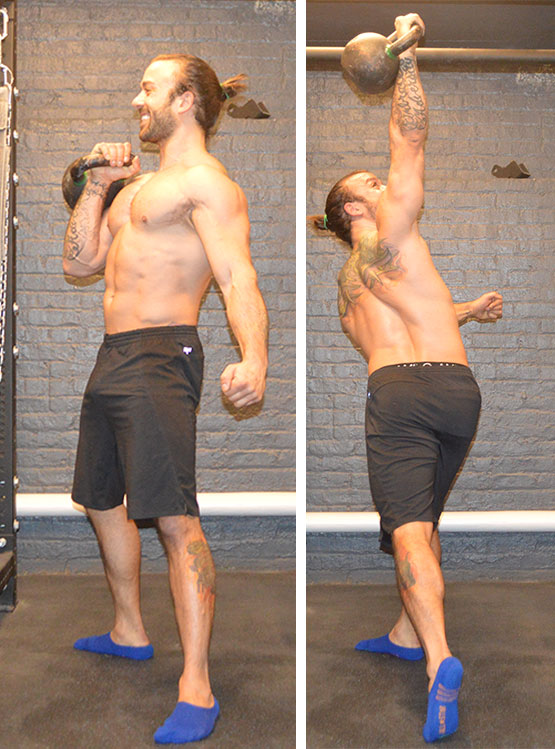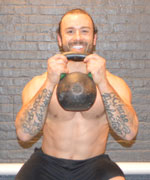RKC Fundamentals + IST Variations: Goblet Squat & Overhead Press
By Angelo Grinceri, RKC, PCC, Author of Intrinsic Strength
As trainers, coaches, and everyday athletes we know:
- Strength is a skill.
- Skills improve with repetition.
- Repetition without variation gets stale.
- Staleness hinders enthusiasm, performance, and progress.
The focus of my training revolves around a few simple things:
- Building strength for every day life.
- Building and toning muscle.
- Increasing HR, metabolizing fat, and sweat.
- Improving coordination, mobility, balance, and foot work.
Throughout my career, I’ve worked, trained, and instructed a plethora of different people and personalities. But, they all had interest in at least one of the above goals. As I get older, I have less time I can commit to working out each week, and I’m less focused of lifting the heaviest weight. But, my need for mobility and feeling good increases.
Back when I was able to get in 5-6 2-hour gym sessions per week, I had plenty of time to fit in extensive mobility work, auxiliary work, capacity work, and heavy grinds. Lately, my gym time has been limited to three sessions each week. With my limited time and hectic schedule, I feel best using full body workouts with hinges, squats, pushes, pulls, and presses—with some loaded and unloaded auxiliary work. I always incorporate different positional variations in these workouts because they bring new benefits beyond just rep, load, and duration alterations:
- Improved active range of motion: Focus on practicing and becoming successful in more positions while predisposing the body for dynamic success.
- Avoiding acute injury: Repetitive movement patterns can lead to excess inflammation, overtraining ligaments and tendons, and a lack of fluidity through dynamic movement.
- Adding a prehab/rehab element: If you don't have time for auxiliary work, train more variations of the basics to move blood, oxygen, and nutrients into different areas of the body.
Three Day Strength Training Program with Goblet Squat and Overhead Press Variations
We know the pelvis and spine are connected, the arms influence the shoulders, and the legs influence the pelvis. If the pelvis, spine and shoulders share layers of connective tissue, then whenever the arms or legs move, the position of the shoulders and pelvis change. When the pelvis or shoulders move, the vertebrae of the spine moves with them. When the bones are moving, then the muscles are active and moving!
How to add IST (Intrinsic Strength Training) variations to fundamental RKC exercises:
Monday (Medium Load - Movement Day)
3 sets of 12 repetitions:
- RKC Goblet Squat x IST Rear Step Squat
- RKC Press x IST Rear Rotation Step Press
Wednesday (Heavy Load - Strict Day) 5 sets of 5 repetitions:
- RKC Goblet Squat
- RKC Strict Press
Friday (Medium Load - Movement Day) 3 sets of 12 repetitions:
- RKC Goblet Squat x IST Rear Rotation Step Squat
- RKC Press x IST Forward Step Press
RKC Cues for Perfecting the Goblet Squat:
- Feet are at—or slightly wider than—shoulder width.
- Lower yourself down into the squat under control, while pulling your chest upward to keep your back flat and actively engage the glutes.
- Breathe through the belly, not the chest to maintain constant core tension.
- If the glutes or ankles are tight, keep pushing the knees outward to keep them from diving inward.
- Bring the elbows inside the knees, push the knees out, and bring the hip crease below the knees.
Why Use IST Squat Variations?
- More time under tension.
- Develop strength in more positions with dynamic foot positions.
- Improve the core. Constant core tension (corset tension) will help maintain spine stability while the legs and pelvis move.
- IST variations encourage a smooth transition of weight distribution from bilateral foot position to single stance leg.
- The option to train the front loaded squat with a static foot position and a dynamic foot position.
- You can train more positions of the squat to mobilize and strengthen the glute complex, and improve single leg strength and stability.
- Loading the legs individually can locate and counteract asymmetries.
- Replicate and train the muscular control and strength to improve the gait.
Angelo's Advice:
"Take time to concentrically and eccentrically control the body’s momentum and force through the weight bearing leg while integrating the lower and upper extremities to find and address asymmetries between each side."
RKC Cues for Perfecting the Press
- Place feet at shoulder width.
- Clean the kettlebell to the rack position.
- Find the standing plank position. Keep legs locked, and fully engage the abs and glutes while keeping the body rigid.
- Keep tension and air in core while the kettlebell is in the rack position.
- Keep the shoulder packed, and latissimus dorsi engaged to keep the shoulder safe from impingement.
- Drive your feet into the ground and engage every muscle while pressing the kettlebell overhead. Hold the fully extended position with the lats engaged and shoulder pulled into the body.
- Pull the kettlebell back into the racked position under control, and maintain tension throughout the entire body.
Why use IST Press Variations?
- More time under tension with the same amount of load. If you do sets of 4 repetitions of a strict press, adding a dynamic step during those reps could increase rep range of that same weight to 6-12.
- As foot positions change, the spine position changes—which will also change the muscular involved and the requirements of the pressing motion.
- As foot positions change, so do the lines of tension created through the body, so you can train the different slings throughout the body.
- Dynamic foot positions develop strength in more body positions.
- IST press variations improve constant core tension (corset tension) while maintaining spine stability while the legs and pelvis move.
- They allow you to practice a smooth transition of weight distribution from bilateral foot position to single stance leg while pressing overhead.
- Train more positions of the overhead press with resistance to mobilize and strengthen the shoulder complex.
Angelo’s Advice:
"If the right hand is pressing and right foot is stepping forward—all the tension throughout the core and body will radiate from the right hand, through the core, and into the left foot. Be aware of asymmetries between each side."
RKC + IST STEP BY STEP
Strict Kettlebell Press & IST Rear Rotational Press

- Start with the kettlebell in front rack position with feet shoulder width apart.
- Complete one strict press then lower the kettlebell to rack position.
- If you are holding the kettlebell on the right, take a rear rotation step with the right foot.
- With this rear rotation step, simultaneously press the kettlebell overhead.
- Focus on creating a full body rotation from the weight loaded leg through the pelvis and each spinal vertebrae.
- Continue to create full body rotation through the scapula while looking at the kettlebell.
- Find and OWN your lock out position.
- Lower the kettlebell back to rack position while maintaining the rear rotation foot position, and control the tension through the hips.
- Start to press the kettlebell back overhead while rotating and pivoting through the hips again.
- Simultaneously bring your feet back to the starting position while actively pulling the kettlebell back to the rack position.
- Repeat steps 1-10 for repetitions.
Strict Kettlebell Press & IST Forward Step Press
- Start with the kettlebell in the rack position, with feet shoulder width apart.
- Complete one strict press and lower the kettlebell back to rack position.
- If you are holding the kettlebell on the right side, take a step forward with the left foot.
- During the step forward, simultaneously press the kettlebell overhead.
- Focus on creating full body extension through full body tension.
- Find and OWN your lock out position while shifting your weight on to the forward leg. Press through the forefoot of the back leg.
- Stay in the in the forward step foot position, and control the tension through the hips while lowering the kettlebell back to the rack position.
- Press the kettlebell back overhead to the lockout.
- Simultaneously, bring your feet back to the starting position while controlling the eccentric motion of the press.
- Repeat steps 1-9 for repetitions.
Goblet Squat & IST Rear Rotational Step Squat
- Start with feet shoulder width apart. Hold the kettlebell by the horns with both hands at sternum height.
- Complete one goblet squat and return to the standing position.
- Lower yourself into a goblet squat position while simultaneously taking a rear rotation step with the right leg (for this example).
- Shift the weight into the stepping leg to load the glute complex.
- Maintain a upright body posture and control while applying pressure through the glute complex of the stepping leg.
- Keeping the same foot position, squat down with the majority of the weight on the rear leg.
- While keeping the same foot position, stand back up from the goblet squat with the majority of the weight on the rear leg.
- Simultaneously stand up to the starting position.
- Repeat steps 1-8 for repetitions.
Goblet Squat & IST Rear Step Squat
- Start with your feet shoulder width apart. Hold the kettlebell by the horns with both hands at sternum height.
- Complete one goblet squat and return to the standing position.
- Lower yourself into the goblet squat position while simultaneously stepping back with the right foot.
- Keep your weight on the non-stepping leg to load the glute and hamstring complex.
- Maintain a upright body posture and control while applying pressure through the glute complex of the non-stepping leg.
- Keeping the same foot position, squat down with the majority of the weight on the non-stepping leg.
- While keeping the same foot position, stand back up from the goblet squat with the majority of the weight on the non-stepping leg.
- Simultaneously stand up to the starting position.
- Repeat steps 1-8 for repetitions.
Remember, as you move:
Stand tall, with an actively engaged core and strong posture. When standing upright with any type of resistance, you should feel core engagement. Focus on the integration and alignment of your entire body. Eliminate excessive pelvic tilting or slouching, so you are prepared to stop excessive force from leaking directly into the lower back and spine.
 Angelo Grinceri - FAFS, RKC, PCC - is a movement specialist, Coach and author of Intrinsic Strength: A Breakthrough Program for Real-World Functional Strength and True Athletic Power. Angelo reshapes and improves New York City’s finest bodies. His fitness & wellness advice has been featured in PEOPLE, Eat This Not That, bodybuilding.com Gear Patrol, MSN, Muscle & Performance, Fox5NY, Yahoo, Galore, Elite Daily, Wellvyl, The Bouqs, and Cheatsheet. The Sexiest Trainer Alive (says PEOPLE Magazine) has a results and science proven program that improves posture, coordination and movement literacy while burning fat, building muscle and chiseling your core. Follow Angelo on Youtube for additional exercise demonstrations.
Angelo Grinceri - FAFS, RKC, PCC - is a movement specialist, Coach and author of Intrinsic Strength: A Breakthrough Program for Real-World Functional Strength and True Athletic Power. Angelo reshapes and improves New York City’s finest bodies. His fitness & wellness advice has been featured in PEOPLE, Eat This Not That, bodybuilding.com Gear Patrol, MSN, Muscle & Performance, Fox5NY, Yahoo, Galore, Elite Daily, Wellvyl, The Bouqs, and Cheatsheet. The Sexiest Trainer Alive (says PEOPLE Magazine) has a results and science proven program that improves posture, coordination and movement literacy while burning fat, building muscle and chiseling your core. Follow Angelo on Youtube for additional exercise demonstrations.
Back